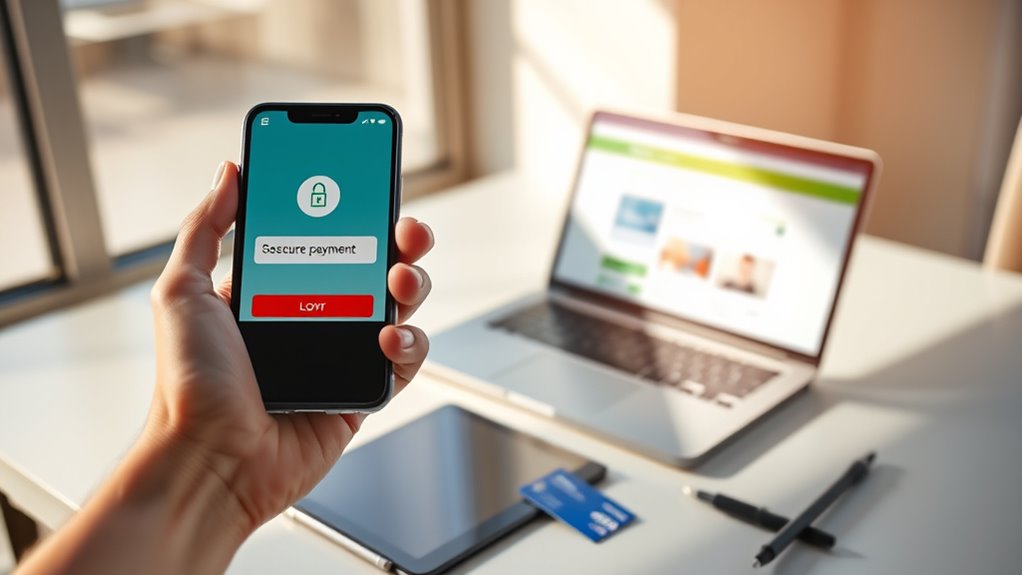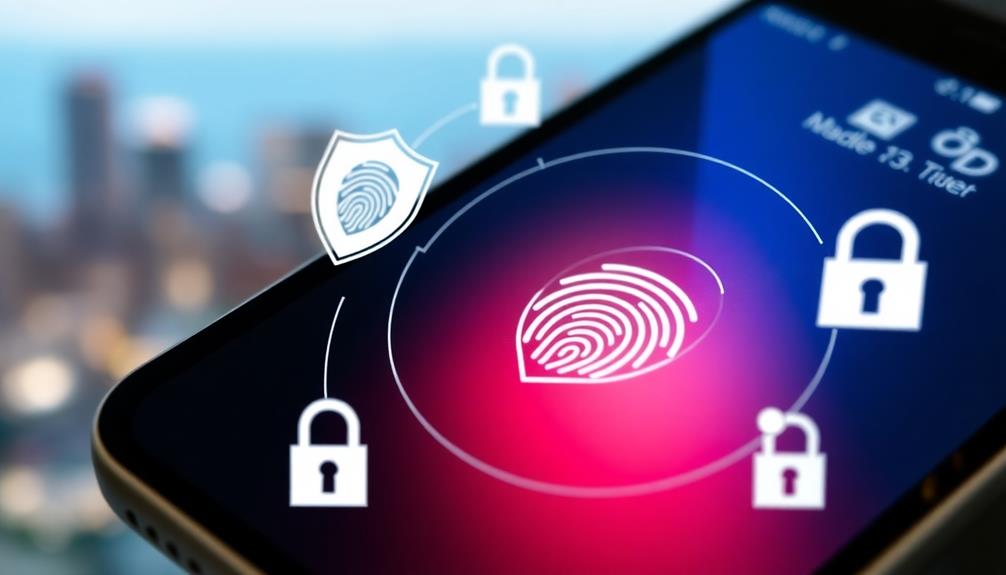To get ready for EMVCo’s Secure Payment Confirmation in CNP transactions, you need to upgrade your payment infrastructure and collaborate with gateways, banks, and providers to support new authentication protocols. Implement APIs for secure confirmation steps and train staff to handle digital authentication properly. Educate your customers on the added security features. Staying compliant with industry standards is key—if you continue exploring, you’ll discover how to fully prepare and benefit from SPC.
Key Takeaways
- Upgrade payment infrastructure to support SPC protocols and ensure system compatibility with EMVCo specifications.
- Collaborate with payment gateways, banks, and software providers for seamless integration of authentication APIs.
- Conduct security assessments and testing to identify vulnerabilities and verify compliance with industry standards.
- Train staff on new authentication methods and educate customers about SPC benefits to encourage adoption.
- Monitor regulatory updates and continuously update security measures to maintain compliance and reduce fraud risks.

As more transactions shift to card-not-present (CNP) environments, preparing for EMVCo’s Secure Payment Confirmation (SPC) becomes essential. In this digital landscape, guaranteeing robust digital authentication is critical to maintaining transaction security. Without physical card verification, online payments face increased risks of fraud, so implementing SPC can help you confidently authenticate customers and protect sensitive data. This protocol aims to improve the trustworthiness of CNP transactions by providing a secure, standardized method for confirming the legitimacy of each payment. As a merchant or payment provider, you need to understand how SPC enhances security measures and what steps to take to integrate it effectively.
As online payments grow, EMVCo’s SPC enhances security through standardized digital authentication, reducing fraud risk in card-not-present transactions.
Digital authentication plays a pivotal role in this process. Unlike traditional card-present methods, CNP transactions lack the physical card’s presence, making digital authentication mechanisms your primary line of defense. With SPC, customers can authenticate their payments using biometric data, one-time passcodes, or other secure methods, which substantially reduces the risk of fraudulent activity. This not only helps you comply with evolving industry standards but also reassures your customers that their data and transactions are protected. You should evaluate your current authentication processes and consider how SPC can complement or replace them to strengthen transaction security.
Preparing for SPC involves upgrading your payment infrastructure to support these new authentication protocols. You’ll need to work closely with your payment gateway, acquiring bank, and software providers to guarantee your systems are compatible with EMVCo’s specifications. This may include integrating APIs that facilitate secure confirmation steps or upgrading point-of-sale and online payment platforms to handle the new authentication flows. Training your staff on the importance of digital authentication and how to troubleshoot issues is equally important, as it guarantees smooth customer experiences. Additionally, educate your customers about the enhanced security features to build trust and encourage adoption. Incorporating user-friendly authentication methods can also improve customer satisfaction and compliance.
Monitoring and testing are crucial during the transition to SPC. You should conduct thorough security assessments to identify potential vulnerabilities and verify that your implementation meets EMVCo’s standards. Regularly updating your systems to incorporate the latest security patches and authentication methods will help you stay ahead of emerging threats. Keep an eye on industry developments and regulatory updates, as these can influence your compliance requirements and security strategies. By proactively preparing and continuously refining your approach, you can leverage EMVCo’s SPC to provide safer, more secure CNP transactions, protect your reputation, and reduce fraud-related losses. Ultimately, embracing digital authentication and transaction security through SPC positions you as a trustworthy, forward-thinking business in a rapidly evolving digital payments landscape.
Frequently Asked Questions
How Does EMVCO Secure Payment Confirmation Impact Transaction Speed?
EMVCo Secure Payment Confirmation can slightly influence transaction speed, but it enhances contactless convenience and fraud reduction. While it adds an extra step to verify the payment, it guarantees quicker and safer transactions overall. You’ll notice minimal delays, and the improved security means fewer fraud-related issues. This balance helps you enjoy seamless contactless payments while benefiting from stronger fraud prevention measures.
What Are the Key Security Benefits of P2P Confirmation?
Imagine a secure handshake that safeguards your transactions. P2P confirmation offers key security benefits by enhancing tokenization security, making sensitive data harder for fraudsters to access. It also strengthens fraud prevention, catching suspicious activity early. This process creates a safer environment for your payments, reducing risks and boosting confidence. By actively verifying each transaction, you enjoy peace of mind knowing your financial data stays protected against threats.
Is Additional Customer Education Required for Implementation?
You’ll need to contemplate customer awareness and user training for successful implementation. While the process enhances security, customers might not understand the new confirmation steps initially. Providing clear instructions and guidance guarantees they’re comfortable with the changes. Investing in user training helps reduce errors and frustration, making the shift smoother. Ultimately, educating your customers about the benefits and procedures boosts their confidence and supports the overall security improvement.
How Does This Influence Cross-Border Transactions?
A picture is worth a thousand words, and when it comes to cross-border transactions, you face unique challenges. EMVCo Secure Payment Confirmation helps improve security, but it also impacts these transactions by addressing cross-border challenges and currency conversion issues. You’ll need to adapt your systems to guarantee seamless, secure payments across borders. This may involve additional customer education, but it ultimately boosts trust and reduces fraud risks in international commerce.
What Are the Compliance Deadlines for Merchants?
You need to be aware of the compliance deadlines to guarantee fraud reduction and avoid penalties. These deadlines address compliance challenges that merchants face when adopting new security standards. Staying on top of these timelines helps you implement necessary measures, such as secure payment confirmation protocols, reducing fraud risks. Timely compliance is vital to smoothly shift and protect your business from potential vulnerabilities associated with card-not-present transactions.
Conclusion
As you prepare for EMVCo’s secure payment confirmation, remember that staying ahead means protecting your customers and building trust. Are you ready to embrace this new standard and guarantee smooth, secure transactions? By taking proactive steps now, you’ll not only enhance your payment security but also demonstrate your commitment to your customers’ safety. The future of card-not-present payments is here—are you prepared to lead the way?










